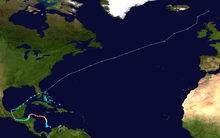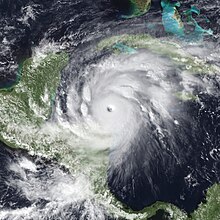Meteorological history of Hurricane Mitch
 Track of Hurricane Mitch | |
| Meteorological history | |
|---|---|
| Formed | October 22, 1998 |
| Extratropical | November 5 |
| Dissipated | November 9, 1998 |
| Category 5 major hurricane | |
| 1-minute sustained (SSHWS/NWS) | |
| Highest winds | 180 mph (285 km/h) |
| Lowest pressure | 905 mbar (hPa); 26.72 inHg |
| Overall effects | |
| Areas affected | Central America (particularly Honduras and Nicaragua), Yucatán Peninsula, South Florida |
Part of the 1998 Atlantic hurricane season | |
| History
Effects Other wikis | |
At peak intensity, Mitch maintained
Origins

The origin of Hurricane Mitch can be traced to a
Upon being classified, Tropical Depression Thirteen was already near tropical storm status, with established
Intensification

When Mitch was upgraded to tropical storm status, it had a small radius of maximum winds, only 9 mi (14 km) at flight-level. A trough moving through the eastern United States weakened a ridge to the north, allowing the storm to move slowly northward.[5] Additional ridging was forecast to build behind the trough, which would turn Mitch to the west to an area near the Yucatán Channel in five days.[6] Significant intensification was initially hampered by the upper-level low to the northwest generating wind shear over Mitch.[1] As a result, the convection weakened on October 23, despite an otherwise improving cloud pattern.[7] Tropical cyclone forecast models anticipated significant strengthening to winds of 115 mph (185 km/h) once an anticyclone aloft became established, although the NHC noted that "it [was] difficult to visualize such intensification with the present poorly defined pattern observed on satellite, and knowing that the global models tend to get rid of westerlies too fast."[8] After about 12 hours of being disorganized, the thunderstorms reformed early on October 24,[9] after the upper-level low weakened and shear diminished.[1] An eye quickly formed in the center of the convection. Based on Hurricane Hunter reports of 105 mph (169 km/h) flight-level winds, the NHC upgraded Mitch to hurricane status on October 24. By that time, the storm was moving slowly to the north,[10] located about 295 mi (475 km) south of Kingston.[1]
Shortly after becoming a hurricane, Mitch began undergoing
The NHC estimated that Mitch intensified into a
Central America landfall
| Most intense Atlantic hurricanes | |||||
|---|---|---|---|---|---|
| Rank | Hurricane | Season | Pressure | ||
| hPa | inHg | ||||
| 1 | Wilma | 2005 | 882 | 26.05 | |
| 2 | Gilbert | 1988 | 888 | 26.23 | |
| 3 | "Labor Day" | 1935 | 892 | 26.34 | |
| 4 | Rita | 2005 | 895 | 26.43 | |
| 5 | Allen | 1980 | 899 | 26.55 | |
| 6 | Camille | 1969 | 900 | 26.58 | |
| 7 | Katrina | 2005 | 902 | 26.64 | |
| 8 | Mitch | 1998 | 905 | 26.73 | |
| Dean | 2007 | ||||
| 10 | Maria | 2017 | 908 | 26.81 | |
| Source: HURDAT[16] | |||||
While Mitch was at peak intensity, the NHC noted that it was "not yet clear which country or countries in the northwest Caribbean are most threatened." By late on October 26, the Navy Operational Global Atmospheric Prediction System (NOGAPS) had forecast the hurricane to continue to the west and strike Belize, while the Geophysical Fluid Dynamics Laboratory (GFDL) computer model anticipated a general movement to the north in the western Caribbean.[18] Mitch maintained peak winds for about 12 hours, and around that time it moved over Swan Island offshore Honduras. The motion became more westward, despite continued predictions for a northerly turn.[1] The convection around the eye became ragged on October 27.[19] Gradual weakening occurred due to the southern half of the circulation moving across Honduras,[20] which cut off inflow from the south. The eye became less distinct,[21] and early on October 28, Mitch weakened below Category 5 status.[1]
Due to a weak mid-level anticyclone over the Gulf of Mexico that was not observed operationally, Mitch began a slow southerly motion on October 27, passing very near
Late on October 29, Mitch weakened to tropical storm status. It moved slowly across Honduras, turning to the west. The large circulation dropped heavy rainfall throughout Central America, particularly in Honduras and Nicaragua, causing widespread flooding.[1] While over land, Mitch initially maintained an area of deep convection,[25] which allowed it to maintain tropical storm force winds.[1][26] On October 31, the circulation became poorly defined while moving over increasingly mountainous terrain; however, the strongest convection persisted over the adjacent Pacific Ocean, and the NHC noted the potential for Mitch to become a Pacific tropical cyclone.[27] Later that day, Mitch weakened into a tropical depression near the border of Guatemala and Honduras.[1] An approaching trough weakened the ridge in the western Gulf of Mexico, allowing Mitch to make the long-intended turn to the northwest.[28] Convection gradually diminished,[29] and the surface circulation of Mitch dissipated on November 1 near the border of Mexico and Guatemala.[1]
Regeneration and extratropical transition

Although the surface low pressure center dissipated, the remnants of Mitch maintained a circulation aloft that reached the
While Mitch was over eastern Mexico, it had a rainband of deep convection in the eastern periphery. With moderately warm waters and the potential for baroclinity, re-intensification was expected.[31] After emerging into the Gulf of Mexico for a second time on November 4, Mitch restrengthened into a tropical storm,[1] although it was not a purely tropical cyclone; convection was minimal near the core, and the strongest winds were over 230 mi (370 km) from the center.[32] Mitch accelerated toward the coast of Florida as it interacted with the approaching cold front.[1] On November 5, the circulation became elongated, and the NHC commented that "if [it] were not the remnants of Mitch, [they] would probably not be calling [it] a tropical cyclone."[33] The storm strengthened to reach winds of 65 mph (100 km/h) before making a final landfall in southwestern Florida near Naples. It quickly crossed the state, producing five tornadoes and tropical storm-force winds, and the storm emerged into the southwestern Atlantic Ocean.[1] Late on November 5, a Hurricane Hunters flight could not locate a well-defined center associated with Mitch, instead observing an elongated circulation embedded in the cold front. Based on the observations, the NHC declared Mitch as an extratropical cyclone.[34]
The extratropical remnants of Mitch continued quickly to the northeast. On November 6, they passed north of Bermuda, and the following day intensified slightly to winds of 70 mph (110 km/h). By November 9, the remnants passed west of the British Isles, and were last monitored by the NHC later that day.[1]
See also
References
- ^ a b c d e f g h i j k l m n o p q r s t u v w x y John L. Guiney; Miles B. Lawrence (2000-05-04). Hurricane Mitch Preliminary Report (PDF) (Report). National Hurricane Center. Archived from the original (PDF) on 2020-03-26. Retrieved 2020-04-09.
- ^ a b c Lixion Avila (1998-10-22). Tropical Depression Thirteen Discussion Number 1 (Report). National Hurricane Center. Archived from the original on 2017-10-23. Retrieved 2013-05-12.
- ^ Richard Pasch (1998-10-22). Tropical Depression Thirteen Discussion Number 2 (Report). National Hurricane Center. Archived from the original on 2017-10-23. Retrieved 2013-05-12.
- ^ a b Ed Rappaport (1998-10-22). Tropical Depression Thirteen Discussion Number 3 (Report). National Hurricane Center. Archived from the original on 2016-03-04. Retrieved 2013-05-12.
- ^ a b Ed Rappaport (1998-10-22). Tropical Storm Mitch Discussion Number 4 (Report). National Hurricane Center. Archived from the original on 2016-03-04. Retrieved 2013-05-12.
- ^ Lixion Avila (1998-10-23). Tropical Storm Mitch Discussion Number 5 (Report). National Hurricane Center. Retrieved 2013-05-12.
- ^ John Guiney (1998-10-23). Tropical Storm Mitch Discussion Number 6 (Report). National Hurricane Center. Retrieved 2013-05-12.
- ^ Lixion Avila (1998-10-23). Tropical Storm Mitch Discussion Number 7 (Report). National Hurricane Center. Retrieved 2013-05-12.
- ^ Miles Lawrence (1998-10-24). Tropical Storm Mitch Discussion Number 9 (Report). National Hurricane Center. Retrieved 2013-05-12.
- ^ Ed Rappaport (1998-10-24). Hurricane Mitch Discussion Number 10 (Report). National Hurricane Center. Retrieved 2013-05-12.
- ^ Miles Lawrence (1998-10-24). Hurricane Mitch Discussion Number 11 (Report). National Hurricane Center. Retrieved 2013-05-12.
- ^ a b Lixion Avila (1998-10-24). Hurricane Mitch Discussion Number 12 (Report). National Hurricane Center. Retrieved 2013-05-12.
- ^ Miles Lawrence (1998-10-25). Hurricane Mitch Discussion Number 16 (Report). National Hurricane Center. Retrieved 2013-05-12.
- ^ Max Mayfield (1998-10-25). Hurricane Mitch Discussion Number 14 (Report). National Hurricane Center. Retrieved 2013-05-12.
- ^ Richard Pasch (1998-10-26). Hurricane Mitch Discussion Number 18 (Report). National Hurricane Center. Retrieved 2013-05-12.
- ^ a b "Atlantic hurricane best track (HURDAT version 2)" (Database). United States National Hurricane Center. April 5, 2023. Retrieved April 18, 2024.
 This article incorporates text from this source, which is in the public domain.
This article incorporates text from this source, which is in the public domain.
- ^ Miles Lawrence (1998-10-26). Hurricane Mitch Public Advisory Number 21 (Report). National Hurricane Center. Retrieved 2013-05-12.
- ^ Miles Lawrence (1998-10-26). Hurricane Mitch Discussion Number 21 (Report). National Hurricane Center. Retrieved 2013-05-12.
- ^ Miles Lawrence (1998-10-27). Hurricane Mitch Discussion Number 24 (Report). National Hurricane Center. Retrieved 2013-05-12.
- ^ Miles Lawrence (1998-10-27). Hurricane Mitch Discussion Number 25 (Report). National Hurricane Center. Retrieved 2013-05-12.
- ^ Richard Pasch (1998-10-28). Hurricane Mitch Discussion Number 26 (Report). National Hurricane Center. Retrieved 2013-05-12.
- ^ John Guiney (1998-10-28). Hurricane Mitch Discussion Number 27 (Report). National Hurricane Center. Retrieved 2013-05-12.
- ^ Ed Rappaport (1998-10-28). Hurricane Mitch Discussion Number 29 (Report). National Hurricane Center. Retrieved 2013-05-12.
- ^ John Guiney (1998-10-29). Hurricane Mitch Discussion Number 31 (Report). National Hurricane Center. Retrieved 2013-05-12.
- ^ Miles Lawrence (1998-10-30). Tropical Storm Mitch Discussion Number 36 (Report). National Hurricane Center. Retrieved 2013-05-12.
- ^ Miles Lawrence (1998-10-30). Tropical Storm Mitch Discussion Number 37 (Report). National Hurricane Center. Retrieved 2013-05-12.
- ^ Miles Lawrence (1998-10-31). Tropical Storm Mitch Discussion Number 39 (Report). National Hurricane Center. Retrieved 2013-05-12.
- ^ John Guiney (1998-10-31). Tropical Depression Mitch Discussion Number 41 (Report). National Hurricane Center. Retrieved 2013-05-12.
- ^ Ed Rappaport (1998-11-01). Tropical Depression Mitch Discussion Number 42 (Report). National Hurricane Center. Retrieved 2013-05-12.
- ^ Richard Pasch (1998-11-03). Tropical Storm Mitch Discussion Number 46 (Report). National Hurricane Center. Retrieved 2013-05-12.
- ^ a b Ed Rappaport (1998-11-04). Tropical Storm Mitch Discussion Number 47 (Report). National Hurricane Center. Retrieved 2013-05-12.
- ^ Ed Rappaport (1998-11-04). Tropical Storm Mitch Discussion Number 49 (Report). National Hurricane Center. Retrieved 2013-05-12.
- ^ Max Mayfield (1998-11-05). Tropical Storm Mitch Discussion Number 51 (Report). National Hurricane Center. Retrieved 2013-05-12.
- ^ Ed Rappaport (1998-11-05). Tropical Storm Mitch Discussion Number 54 (Report). National Hurricane Center. Retrieved 2013-05-12.

